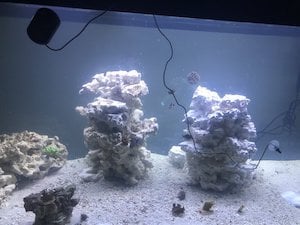"Why is my alkalinity rising?" is a seemingly simple question that consistently pops up in the chemistry section of Reef2Reef. However, it is a complex question since there are numerous ways alkalinity can accumulate - some ways one may least expect.
The consensus of an alkalinity range in home aquaria is from 7dKH to 12dKH. Going below this range may halt calcification (growth) in organisms containing calcium carbonate; stress corals with the lack of carbonate & bicarbonate in the water; may suppress pH, which can dissolve coral skeletons below about a pH of 7.5. In contrast, very elevated alkalinity can increase the likelihood of precipitation, thus, wasting the alkalinity solution and may stress certain organisms, especially ones without adequate nutrients in the water.
Sodium bicarbonate: a common alkalinity additive.
First and foremost, the way alkalinity can climb in a tank is through deliberate dosing. If you add an alkalinity supplement, but the level rises above your comfort, the obvious solution is to reduce the dose. The amount of solution dosing exceeds the demand for the tank. Some salt mixes, like Instant Ocean's Reef Crystals or Red Sea's Coral Pro Salt, contain higher alkalinity. Water changes may unintentionally exacerbate the issue despite helpful intentions.
An RO/DI system can help prevent unintentionally adding alkalinity to a tank.
Another way alkalinity is rising is due to your source water. Depending on where you live, your tap water can have a significant amount of alkalinity. For example, tap water containing 10dKH and a salt mix containing 10dKH can result in 20dKH saltwater. Continuously topping off your evaporation with tap water may gradually increase the resulting alkalinity.
Elevating alkalinity due to low demand is a great excuse to stock up on corals.
The next way unanticipated elevated alkalinity occurs is from low-demand tanks. It is natural for organics in the sand to have a low localized pH, which dissolves the calcium carbonate. In a well-stocked tank, the amount of calcium and alkalinity added is negligible and unnoticed; however, if there isn't much demand, there can be an apparent rise over time. We expect long-term reefers to replenish their sand bed from the dissolution of calcium carbonate because of this process.
My DIY carbon dosing solution: made with 1,000mL Vinegar, 250mL Vodka, and 4tsp Glucose
Subsequently, the processes of denitrification will increase alkalinity. Reefers who use denitrification systems such as:
- Dosing vodka, vinegar, or sugar.
- Implementing a sulfur denitrator.
- Merely containing a deep sand bed.
Beginners can fall prey to marketing schemes.
Additionally, a frustrating way alkalinity unexpectedly accumulates is from deceitful products. Whether mislabeling products is because of a lack of understanding of chemistry from the manufacturers or from an immoral method of boosting sales, it only hurts us, the consumers. Here are only a few examples of mislabeled products:
- Aquavitro's OH balance. Claims to elevate pH by using a hydroxide blend solution without boosting alkalinity; it's incorrect because any hydroxide solution will dissociate and use CO2 to make carbonate and bicarbonate, resulting in alkalinity.
- Aquavitro's "calcification" is a calcium additive made from calcium gluconate. Despite not stating much about its effect on alkalinity, bacteria will metabolize gluconate, adding alkalinity.
- Brightwell's Boost pH+. "Works with buffers and alkalinity products to increase pH to desirable 8,3, 8.4 or 8.5 levels without increasing alkalinity itself." This statement on the bottle is false. Any additive that raises pH will also raise alkalinity.
Throw out those expired test kits.
The final section will discuss how test errors and unique additives can impact alkalinity. The higher the salinity, the more abundant all the elements become. If you expect your salinity is around 35ppt, but in reality, it is higher due to a miscalibrated device, the alkalinity will be higher than expected (and so will all the other elements in the salt). Some alkalinity kits can test higher the older the regents become, so it is crucial to keep that in mind. The "unique" additives that may raise alkalinity are rocks made from cement, silica dosing (increases a trace amount), some amino acids, and other insignificant sources.
Although it can be frustrating to understand why your alkalinity is unintentionally rising, it can be satisfying once figured out. Elevated alkalinity can cause precipitation issues and can even have a snowball effect where fresh precipitation encourages more to form. Keeping alkalinity stable and in the optimal ranges make for happy and thriving organisms.
Happy Reefing!













